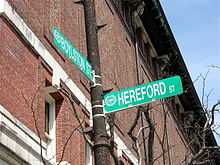Boylston Street


Boylston Street is the name of a major east-west thoroughfare in the city of Boston, Massachusetts. Another Boylston Street runs through Boston's western suburbs.
The Boston street was known as Frog Lane in the early 18th century and was later known as Common Street.
It was later again renamed for Ward Nicholas Boylston (1747–1828),[1][2][3][4] a man of wealth and refinement, an officer of the Crown, and philanthropist. Boylston, who was a descendent of Zabdiel Boylston,[5] was born in Boston and spent much of his life in it. The Boylston Market was named after him as was the town of Boylston, Massachusetts.[3]
Boylston Street, Boston
From west to east, Boston's Boylston Street begins at the intersection of Park Dr. and Brookline Ave. as a two way, four lane road in Boston's Fenway neighborhood where it runs through a swath of parking lots and other underutilized space before forming the northern boundary of the Back Bay Fens at the Storrow Drive/Commonwealth Avenue right-of-way. Traffic traveling west on Boylston here cannot continue on Boylston and must use Ipswich St. to continue west. Here, Boylston St. enters the Back Bay neighborhood where it becomes a major commercial artery carrying three lanes of one way traffic eastbound after Dalton St. As it travels through the Back Bay, it forms the northern boundary of busy Copley Square and provides the southern limits to the Boston Public Garden before becoming a two-way street running along Boston Common's southern edge from Charles Street to Tremont Street. After Tremont St., Boylston returns to carrying one way traffic east before ending at Washington Street in the downtown area where it changes to Essex Street.
The MIT Rogers Building [6] was at 497 Boylston Street when MIT had its original campus in Boston, before it moved to Cambridge in 1916. A plaque on the building serves as a commemoration.
On April 15, 2013, Boylston Street was the scene of two explosive detonations that occurred during the running of the 117th Boston marathon, which killed 3 people and wounded at least 264.
Landmarks
- 500 Boylston Street - a postmodern office building
- 941–955 Boylston Street - formerly a fire station and then home to the Institute of Contemporary Art, now part of the Boston Architectural College
- Back Bay Fens
- Berklee College of Music
- Boston Common
- Boston Public Garden
- Boston Public Library
- Copley Square
- Emerson College - several buildings are located along the street across from Boston Common
- Hynes Convention Center
- Old South Church
- Saint Clement's Eucharistic Shrine
- Saint Francis House - a former Boston Edison Electric Illuminating Company building
- Steinert Hall
- Trinity Church
Shopping
- Anne Fontaine
- Apple Store
- Escada
- Frette
- Gucci
- Hermès
- La Perla
- Lord & Taylor
- Lululemon Athletica
- Sonia Rykiel
- St. John
- The Tannery[7]
As part of plans to re-develop the stretch of Boylston between Ipswich and Brookline Ave., a Guitar Center went under construction and relocated to 1255 Boylston Street. This location is convenient due to the proximity of Berklee College of Music and Landsdowne Street. Other properties had also been purchased in an effort to improve the area.
Transportation
MBTA Green Line transit links along Boylston Street, from east to west:
- Boylston (MBTA station)
- Arlington (MBTA station)
- Copley (MBTA station)
- Hynes Convention Center (MBTA station)
- Fenway (MBTA station)
Boylston Street, Newton and Brookline
The suburban Boylston Street is distinct from the one in the city of Boston, and this part of the Worcester Turnpike was given that name in 1841, after a local Brookline family.[8] It begins as the continuation of Route 9 at the Wellesley/Newton line and serves Newton and Brookline before ending at the border of the city of Boston, at the intersection with Brookline Ave. From there, the street (and Route 9) continue east into central Boston as Huntington Avenue.
MBTA Green Line D Branch stations along this route include:
References
| Wikimedia Commons has media related to Boylston Street (Boston, Massachusetts). |
- ↑ "Ward Nicholas Boylston", Princeton (Massachusetts) Historical Society
- ↑ Drake, Samuel Adams. Old landmarks and historic personages of Boston. Boston : James R. Osgood and Co., 1873.
- ↑ 3.0 3.1 Bentinck-Smith, William, "Nicholas Boylston and His Harvard Chair", Proceedings of the Massachusetts Historical Society, Third Series, Vol. 93, (1981), pp. 17-39
- ↑ "A Letter from Nicholas Boylston (1771?-1839)", Bulletin of the Public library of the city of Boston, The Trustees, 1921. Cf.pp.307-309.
- ↑ "Boylston Family Papers: 1688-1979", Massachusetts Historical Society.
- ↑ "Massachusetts Institute of Technology : President's Report 1921". Mentions the Rogers Building on Boylston Street in Boston.
- ↑ thetannery.com
- ↑ "PROCEEDINGS OF THE BROOKLINE HISTORICAL SOCIETY AT THE ANNUAL MEETING, JANUARY 23, 1907 BROOKLINE, MASS. PUBLISHED BY THE SOCIETY MCMVII. THE "OLD WORCESTER TURNPIKE."". Retrieved 2012-08-12.
| KML file (edit) |
| ||||||||||||||||||||||||||||||||||

